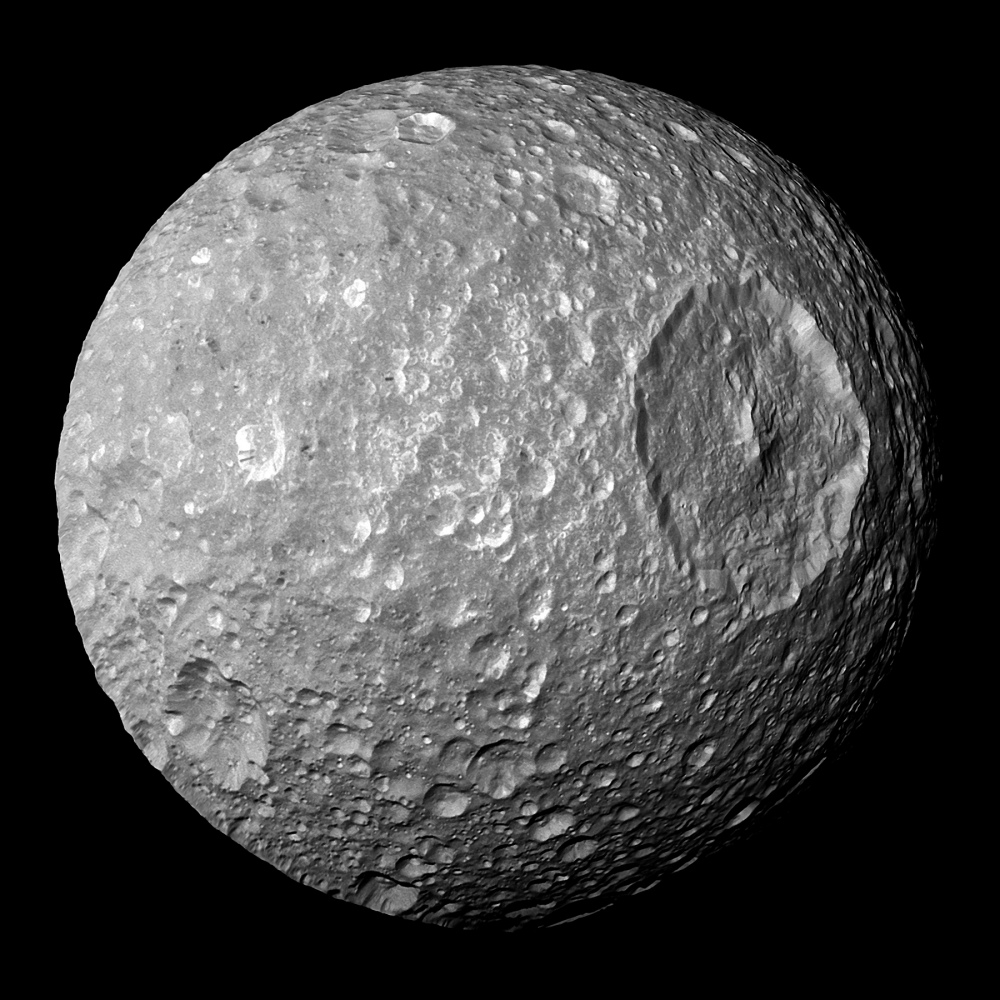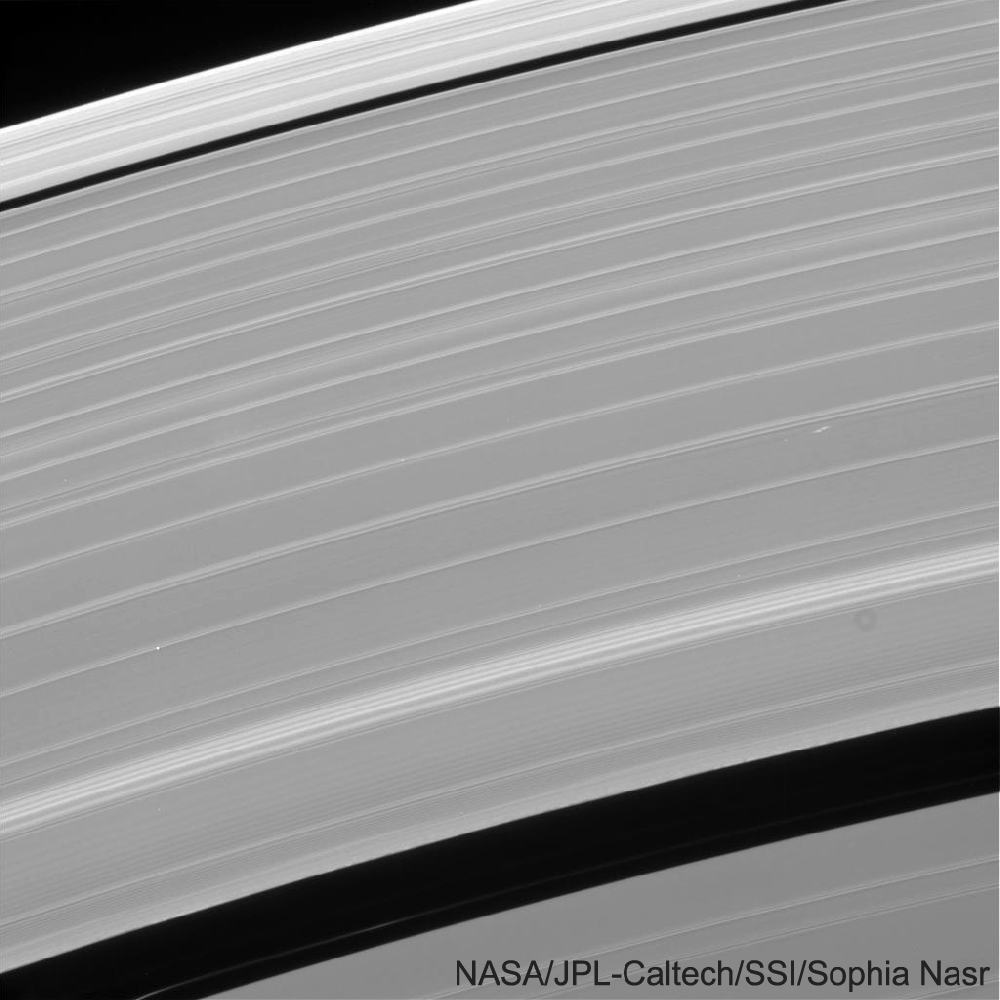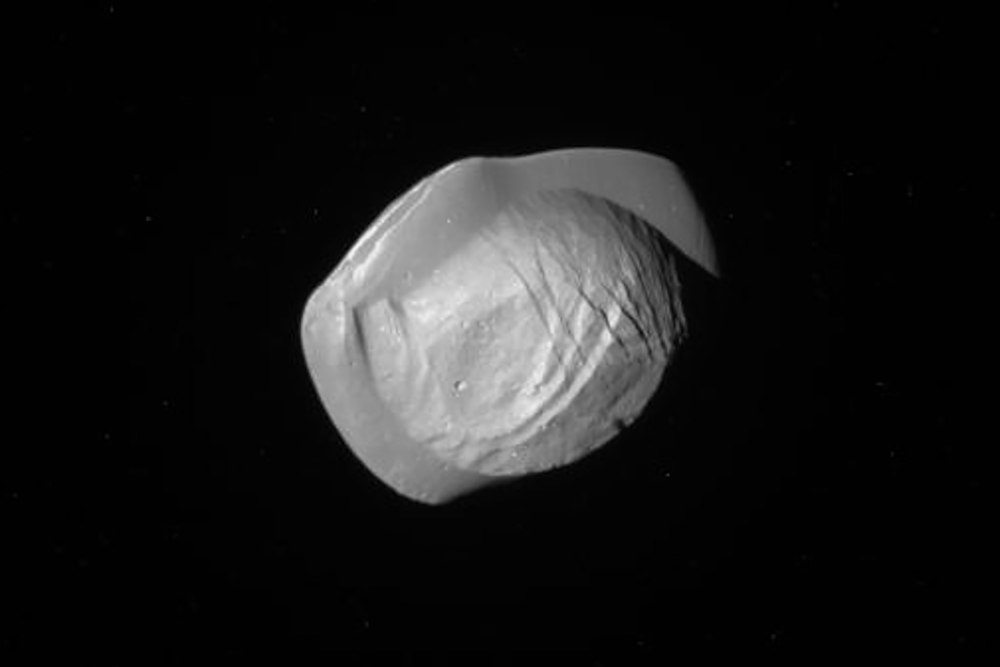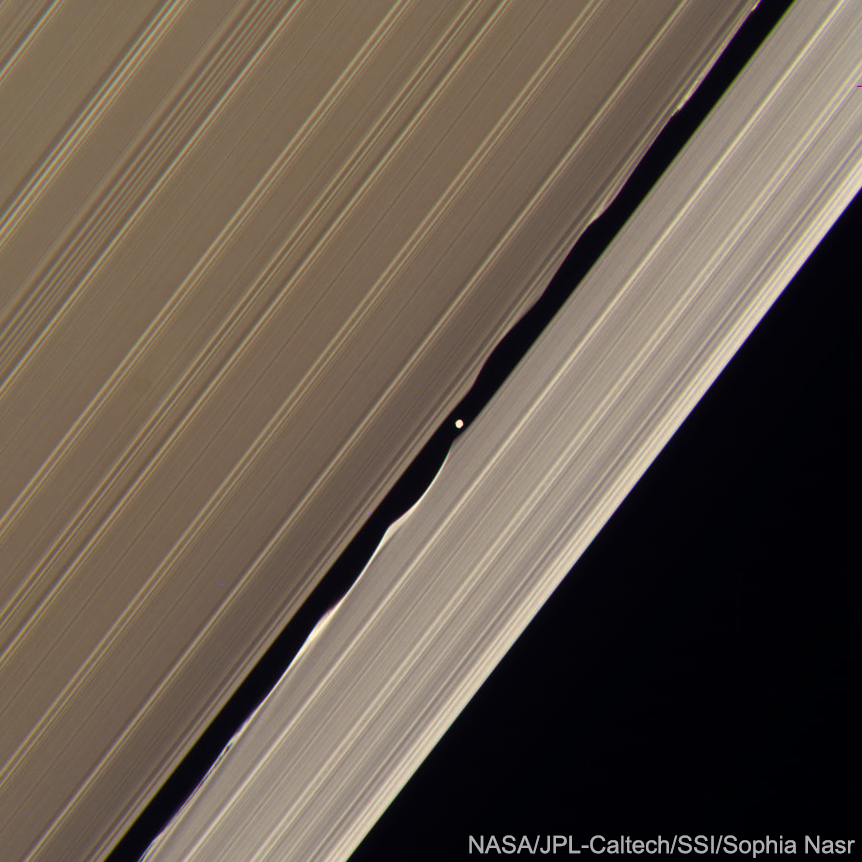
Data taken by Cassini of Saturn’s A-ring, B-ring, the Cassini Division, and Huygens gap, on May 25, 2017. Credit: NASA/JPL-Caltech/SSI/Sophia Nasr
Sometimes I find raw data from Cassini and think it really needs to be turned into a GIF. And when that data features Saturn’s rings, you know I’ll be on it! (As you will learn, I’m slightly obsessed with Saturn’s rings… but then, who isn’t?!)
The interesting thing about this data set is that the rings are so heavily sunlit here that Saturn’s B-ring is almost entirely washed out. May 25, 2017. What’s striking, however, is the detail we get in the Cassini Division—the gray area that stands out in this GIF. Further out, we get some detail in the A-ring, and then it’s washed out again. Just for reference, looking from the lower right to the upper left, we’re looking at Saturn’s B-ring, followed by the Huygens gap, followed by the stunning Cassini division, and finally, the A-ring. For more clarity, you can take a look at a high-definition Ring Scan featured on APOD. And, you’ll remember in my previous blog post that the B-ring is the spot for spokes!
Saturn’s rings are made up of mostly ice particles, ranging from the size of a grain of sand to several meters across, and trace amounts of rocky dust material as well. The ice particles are what make its rings so reflective, making Saturn the only planet with rings visible to the naked eye (and spectacular, at that). The width of Saturn’s main rings are about 300,000 km in extent, but some fainter rings extend far further—the E-ring a ring composed of ice particles only microns thin, extends out to the orbit of Titan! So wide they are indeed, but extremely thin—tens of meters thin!! Why are they thin? Well, the short answer to that is physics. The explanation is as follows: when a ring particle has an orbit that’s inclined to the plane, it has more orbital energy than do the ones in the ring. So when those with highly-inclined orbits collide with those in the rings, they lose orbital energy and are kind of forced back into the lower energy orbit, creating this flattened ring we see today. You can find good explanation and link to a detailed analysis of this mechanism given by my friend and astronomer Phil Plait.
Now, let’s talk about the rings (and gap) of interest in this GIF. Let’s start with the brightest, most massive ring of the Saturnian system—the B-ring! This stunning ring is about 25,500 km wide, and doesn’t seem to have any gaps in it. It does, however, appear to have moonlets—mini moons a few hundred kilometers across—in it.
Strange Things Afoot in the B Ring. Credit: NASA/JPL_Caltech/SSI
When you play the video above, you’ll notice a clump moving in orbit near the edge of Saturn’s B-ring. This is one of a couple such features in the B-ring; the mass, or moonlet, appears to be orbiting Saturn independently of the ring. And because of the moonlet’s mass, it exerts its gravitational force on the particles in the ring, flinging ice particles up while it moves! That creates that feature you see in the above video.
Saturn’s B-ring is even more complex than stated above. Oscillations in the ring material cause the waves and formations in the B-ring to move up and down, as you can see in this video. This behavior, along with embedded moonlets, causes these weird and beautiful vertical structures to form in the outer B-ring, as seen below:

Vertical structures in Saturn’s B-ring seen by Cassini in 2009. Credit: NASA/JPL-Caltech/SSI
With all this interesting stuff going on in the B-ring, scientists think it behaves the way a galaxy does. You can read more on this, and the oscillations described above, in an article written by science journalist Nancy Atkinson.
So the B-ring is a dense place with a mass nearly the same as Saturn’s moon Mimas (yup, our solar system’s very own death star). Let’s talk about something far less massive, but no less interesting—the Huygens Gap!
The Huygens Gap, found right in between the B-ring and the Cassini Division in the GIF above, is a gap formed by an orbital resonance with Saturn’s moon Mimas, where the resonance with Mimas is the location of the gap, and the Cassini Division (more on this next). The gap ranges to up to 400 km in width. An orbital resonance is caused by our favorite friend—gravity. Mimas exerts a force of gravity, and orbiting Saturn, it’s at just the right place to exert a gravitational pull in the Huygens Gap, pulling material out of it. So in that region, for every two orbits made, Mimas makes one, ie a 2:1 resonance. There’s also a ringlet in the gap (the thin white band just below the Cassini Division in the GIF). That ringlet has some irregularities in it, probably caused by the orbital resonance. Orbital resonances are all over the solar system! For example, three of Jupiter’s Galilean moons, Io, Europa, and Ganymede, have a 4:2:1 resonance. And Pluto is in orbital resonance with Neptune, a 2:3 resonance. So basically, the reason we get the Huygens Gap in Saturn’s rings is because gravity and orbital mechanics. And with all this talk of Mimas, our very own Death Star, I think it would be nice to show off an image of this beautiful moon:

A mosaic of 6 images of Mimas, taken by Cassini Feb 13, 2010. Credit: NASA/JPL-Caltech/SSI
Let’s move out to a really interesting spot, and the highlight (in my opinion) of the GIF: The Cassini Division. The Cassini Division, about 4700 km wide, lies between Saturn’s A-ring and B-ring. This is the “gap” you’ll see when you look at Saturn through a telescope, or images of Saturn taken through a telescope, but it’s no gap—there is ring material in there. Similar to the C-ring, the material here is made up of ice particles, but covered in a dark material that makes it harder to see. But there are gaps in this material, and it’s really sparse, because these particles are in orbital resonance with Mimas—2:1 (this resonance appears to mostly affect the inner portion of the Cassini Division, close to the Huygens Gap). The moon Mimas pulls on the material, forcing particles out of the Cassini Division. You can read more about this, and other resonances created by our very own Death Star, in an article by Matt Williams for Universe Today.
This brings us to the A-ring, a place of wonder, and soon, you’ll see why. Saturn’s A-ring is some 14,600 km in width. The A-ring hosts two gaps—the Encke Gap and the tinner Keeler Gap—and a bunch of propellers. Oh, also, the A-ring hosts some brilliant features caused by spiral density waves. So this is going to be a long section, but well worth your read!
Let’s start with the spiral density waves. I made a GIF of Cassini data taken on May 15, 2017, that features everything we’re going to discuss: spiral waves, the Encke Gap, the Keeler Gap, and a propeller! Here’s the GIF:

Data of Saturn’s A-ring, featuring the Encke Gap, Keeler Gap, and a propeller, taken by Cassini on May 15, 2017. Credit: NASA/JPL-Caltech/SSI/Sophia Nasr
This GIF features the Encke Gap, with one knotty ringlet clearly visible, the thinner Keeler Gap above, a propeller that swings by near the center, and spiral density waves! But the spiral density waves deserve a bit more attention. Here’s a nice close-up, which I got from planetary scientist Emily Lakdawalla’s blog:

Spiral waves seen in Saturn’s A-ring, taken by Cassini on Apr 8, 2008.
Credit: NASA/JPL-Caltech/SSI
These strange and beautiful features are created by orbital resonances with Saturn’s outer moons. Emily Lakdawalla explains these really well in the link from which I got the cool image above.
Next, we move onto the Encke Gap. This gap, some 325 km wide, is cleared by the gravity of a special moon named Pan. Here’s an image of this weird space ravioli/pierogi moon, taken on March 7, 2017:

Saturn’s space pierogi moon Pan. Taken by Cassini on March 7, 2017.
Credit: NASA/JPL-Caltech/SSI
This moon, with a mean radius of about 14 km, clears a gap in Saturn’s rings by kicking particles out with its gravity. You’ll also notice in the GIF, that just above the gap, you’ll see disturbances—these are also caused by Pan. They’re called spiraling wakes, and they’re caused because the particles closer to Pan move faster than those further away (just a statement of Kepler’s Laws), so Pan’s gravity creates these disturbances in the ring material. Pan shares this gap with a few ringlets, one visible in the GIF. You’ll notice it’s kinda knotty—this is probably due to Pan’s gravity as well.
Now let’s move onto the Keeler Gap—my favorite!! This gap is only about 42 km wide, and created by a lovely moon Daphnis, with a mean radius of about 4 km (but it’s shaped like a potato):

Saturn’s moon Daphnis, taken by Cassini on Jan 19, 2017.
Credit: NASA/JPL-Caltech/SSI/Matúš Motlo
Now, let’s get to the cool stuff. I processed an image that was really difficult to put together, because I had to rotationally align them—that is, Cassini’s perspective didn’t just change in an up-and-down direction between the red, green, and blue filter images, but it also changed in that it slightly rotated. The result is something I’m pretty happy with, because it shows a lot of what I’m about to discuss, and in color:

Daphnis making Waves in Saturn’s rings, taken by Cassini on Feb 6, 2017.
Credit: NASA/JPL-Caltech/SSI/Sophia Nasr
Okay so what are we seeing here?! Well, we’re seeing the gravitational effects of Daphnis on Saturn’s ring material in the Keeler Gap! But, why the waves, and material moving upwards?? Well, turns out Daphnis has an eccentric orbit, bringing it closer and farther from the material, depending on the point in its orbit. Because of this, Daphnis has a stronger gravitational pull on the material when it’s closer, which created waves. But its orbital inclination is what’s owed the credit for bringing material up or down from the ring plane. You can see in the image above that some material looks like it’s being pulled up below Daphnis, and down ahead of Daphnis. But wait, there’s more! Notice how below Daphnis, the waves only appear on the outer ring, and ahead of Daphnis, on the inner ring? That’s because of the orbital velocities of the particles in the rings—the particles in the inner ring move faster than Daphnis, and those in the outer ring move slower than Daphnis, which is why the leading waves are in those moving faster, and the trailing ones, in the ones moving slower. This is why the Keeler Gap and Daphnis are my favorite feature in Saturn’s rings!
Now, finally, we talk about the propeller you see in the GIF. It’s worth zooming in on one, the largest (known) propeller in Saturn’s rings, Bleriot (which I think is the same one you see in the GIF):

Bleriot Propeller in Saturn’s A-ring, taken by Cassini on Apr 12, 2017.
Credit: NASA/JPL-Caltech
So, what is this thing, and how many are there? Well, to answer the second question, Saturn’s rings are full of propellers—they’re all over the place!! How are they formed? Now this is where it gets interesting. First, these propellers are formed by moonlets—mini moons only a couple of hundred meters across. These moonlets are trying to do what Daphnis and Pan do—clear a gap in Saturn’s rings. But they’re small, so the gravity they exert is smaller as well. So they fail to clear a gap throughout Saturn’s ring, but they succeed in clearing one within their vicinity. They actually can kick up material 0.5 km above/below the ring plane! But it’s even more interesting because of the shape. Why a propeller? Well, orbital mechanics and gravity are yet again responsible! We basically have a gravitational tug-of-war going on between the moonlet and Saturn. Let’s start with the ring material that’s ahead of the moonlet. These particles have an associated with them some orbital angular momentum; now, the moonlet uses its gravity to pull these particles towards it, causing those particles lose some of their momentum, and they fall inward due to Saturn’s gravity, and then go merrily along in their path, slightly inward from the moonlet. This happens throughout the moonlet’s orbit, creating the forward propeller. Now, those particles behind the moonlet are pulled in, which gives them a boost in orbital energy, causing them to fling ourward. Occuring throughout the moonlet’s orbit, you get the rear end of the propeller. Phil Plait explains this much better, here. And voila! You have a propeller in the ring!
In summary, a lot of the cool stuff we see in Saturn’s rings is owed to gravity and orbital mechanics. Physics, my friends, is why you see stuff that’s this cool.
Very interesting, intriguing even
LikeLike
What a meaty post! Are there 8th fed
LikeLike
Whoops! Stupid touchscreen. ..are there images of those vertical structures in the B ring seen from side on? They would be special.
LikeLiked by 1 person
Not quite—that would destroy the Cassini Spacecraft. But at an angle safe enough to get that shot.
LikeLiked by 1 person
Bummer! They would be amazing shots.
LikeLike